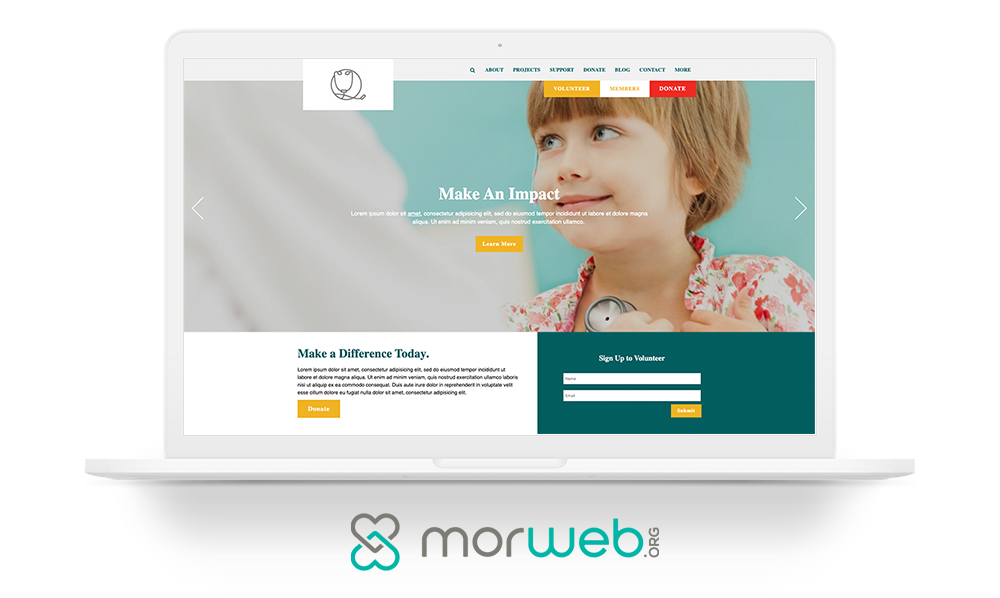Reaching the Right Donors in a Post COVID-19 World
Thanks to Murad Bushnaq, Founder and CEO of Morweb for authoring this guest post. Since its inception in 2014, Murad has acted as Creative Director and Chief Technologist to help nonprofits spread their vision online through engaging design, intuitive software and strategic communication.
Whether you’re a seasoned nonprofit professional or just getting started, you understand the importance of having a strong donor base. It’s no secret that your organization’s success depends on its generous supporters. How will they find you? On your website. Build the content you need to attract donors and other investors who share a passion for your mission and have giving or volunteering capacity. A flexible, easy-to-use content management system (CMS) is a must. The post-COVID19 world requires it.
Attracting and retaining high-quality donors can be challenging for nonprofits of all sizes. It takes a dedicated team to capture and garner this crucial attention, so be prepared to put in the time and effort needed to do so. That team must have the right tools in place, especially an understanding of the ideal donor you want to attract. Consider the term “ideal donor” to be shorthand for every type of investor, including individual and major donors, corporate sponsors, and grant-making organizations.
It’s important to note that every nonprofit is different, so each needs its own customized approach to fundraising. However, there are a few common ways to reach and engage donors that work for any organization, no matter its mission.
To establish a SMART fundraising strategy, keep these proven tips in mind:
- Select the right CMS.
- Optimize your website for mobile users.
- Develop a social media presence.
- Follow up with donors.
Donors are the lifeblood of your organization. Make sure to prioritize them in your fundraising strategy. If you’re ready to build a stronger support system, let’s get started.
.jpg)
1. Select the right CMS
The first place most prospective donors will interact with your organization is online. However, many nonprofits don’t have the technical knowledge necessary to build an effective website from scratch as they have little to no coding experience. Because of this, you’ll need to choose a content management system (CMS) that was designed specifically with nonprofits in mind.
When choosing a CMS, ensure it fulfills all of your organization’s digital needs. Look for comprehensive features such as:
- Drag-and-drop templates. Simplify the design process with a CMS that offers pre-designed elements. Choose which elements you’d like to use. Then, play around until you have a crisp and navigable design.
- Live editing tools. A CMS that offers live editing enables you to make changes on the front-end of your site. You’ll be able to view exactly how changes will look in real-time.
- Configurable donation forms. Your CMS should offer donation form building tools so that you can start collecting donations instantly. Ensure you can offer suggested giving amounts and recurring gift options to drive even more donations through your site.
The right CMS should make it easy for you to update your online content easily, so you can constantly modify your messaging to attract donors whose giving motivations align with your mission, cause or programs. A good CMS will also save you time and money. At least one person (preferably more) in your organization can respond to changing conditions quickly and easily, without waiting for “the website guy” to be available.

With easy-to-understand capabilities, you can quickly refresh your website without frustration. Keep the user experience in mind to produce an effective website that captures donors’ attention. To spark some inspiration for revamping your organization’s website, explore Morweb’s list of best nonprofit websites. You may notice a few elements that you want to incorporate in your design.
Remember those donor motivations! They will change from time to time. Right now, philanthropic individuals, businesses, and foundations are motivated to make life easier, safer, and more secure for those most vulnerable to the pandemic: the elderly, homeless, poor, and marginalized.

2. Optimize your website for mobile users
According to Double the Donation’s nonprofit fundraising statistics, roughly half of all website traffic comes from mobile and tablet users. Whether prospects are researching your organization’s mission or completing your well-designed donation form, they expect your website to work with them, not against them. In other words, mobile optimization is no longer a choice; it’s a necessity.
Your website should be mobile-responsive from end to end. This includes your:
- Web pages
- Forms (donation form, volunteer sign-ups, event registration, etc.)
- Images and videos
- “Call us” link that automatically initiates a call when clicked
When you don’t optimize for mobile users, you risk a higher bounce rate (the rate at which people leave your site after only viewing one page). Without mobile functionality, users will be forced to zoom in and out to read your content and will struggle to complete your online forms, leaving them frustrated. Instead, optimize your website for all screen sizes so that you won’t miss out on any fundraising opportunities. Design your website with the mindset of driving donor engagement no matter what device they’re using, and you’re sure to see positive results.

Remember, a comprehensive CMS will be designed with mobile functionality in mind. Invest in a system that features mobile-responsive designs, so you can spend more time focusing on spreading the word about your cause and garnering donations.
.jpg)
3. Develop a social media presence
With limited budgets, nonprofits have to fight an uphill battle to raise donations and spread the word about their cause. That’s why developing a social media presence is so important for nonprofits big and small.
Regardless of your feelings toward social media, its immense impact on the nonprofit fundraising space is something organizations like yours shouldn’t ignore.
For the best results, develop a social media strategy before you start posting. Determine which sites your supporters are using and then create accounts on those platforms. Then, keep these best tips in mind when crafting your posts:
- Adjust messages based on the platform. Each platform has different requirements. For instance, Twitter has a character limit which is great for succinct updates, whereas Facebook may be the place to post longer appeals.
- Feature impactful imagery. Whether you’re posting to Facebook, to Instagram, or even to LinkedIn, harness the power of visual storytelling to truly motivate your followers. Share images and videos of your work in action.
- Be social. Don’t just broadcast your nonprofit’s messages online and expect results. Rather, interact with supporters online to connect on a personal level. They’ll appreciate that you took the time to respond, which will boost their engagement.
Nowadays, social media is the preferred method of communication for younger generations of donors. Social media can be a real game changer for nonprofits, so make sure to incorporate it in your digital strategy. By developing an online presence, you’ll reach a much wider audience and form a direct line of communication with donors. Using your social presence, you can embed links back to your website to encourage donors and volunteers to sign up for your newsletters, participate in your (virtual) events, and make direct donations.

Blog
Further your social media presence by developing a blog. Craft posts directly on your website, and ensure it’s content worth reading. For instance, regularly update supporters by creating the following posts:
- Progress updates. Keep readers up-to-date on your organization’s programs and projects. Blogging is a great opportunity to let donors know exactly how their donations are making a difference.
- Impact stories. Storytelling can capture supporters’ attention and motivate change. Discuss specifically how your work has impacted the community. For a more engaging story, ask for new perspectives. This could be your donors, volunteers, or even those who your work has impacted.
- Donor/Volunteer spotlights. Use your blog to feature your most involved, passionate supporters. This may incentivize others to step up their efforts to receive their own special shoutout.
Each time you post, share it across each social media platform. To streamline this process, make sure your CMS enables social media share and follow icons. This way, followers can easily share their favorite posts with their personal networks and interact with your organization online. This is great for driving traffic to your website and extending your reach to wider audiences.

4. Follow up with donors
To cultivate stronger relationships with donors, you’ll need to create an open line of communication. Many nonprofits make the mistake of interacting with donors only when making donation appeals, leaving the donor feeling undervalued. Instead, follow up with them to reassure them that their contributions are making a difference.
Let them know how their gifts have helped your organization reach its fundraising goals and how else they can get involved. Remember, your organization depends on its donors’ continued support to maintain its momentum and keep up the good work.
Start by thanking donors as soon as they give. As soon as they submit a gift using your optimized donation page, donors should receive an automatic confirmation email showing appreciation. It should convey your gratitude and feature any important details, such as donation amount and date. Then, you can schedule your email campaigns and even social media posts to promote your cause and provide extra opportunities for interaction. Explore some more donation page best practices here.
For each of your follow-up messages, make sure to:
- Personalize your outreach. Know what connects donors to your cause and leverage that in your outreach. Use their preferred first name and make sure to let them know exactly how their contributions helped your cause (e.g. what program their donation funded).
- Feature involvement opportunities. Offering several opportunities to get involved can substantially boost donor retention. Spread the word about events and volunteer opportunities by featuring them on your website and social media pages. Make sure donors have every chance to support you, and they will.
- Reach out at the correct time. Healthy communication is a two-way street. Make sure to reach out to donors using their preferred contact method at the right time. Otherwise, supporters may ignore your outreach.
Once your donor base starts to grow, reaching out to every donor will quickly become impossible. This is when you’ll want to consider automation technology. Remember, automation doesn’t have to be impersonal. Ensure you can edit any and all automated communications to create the most relevant messages for your audience.
Whether you incorporate one or all of these tips, you need to constantly refresh your fundraising strategy. Remember, reaching and cultivating long-term relationships with supporters starts with a strong online strategy, because that’s the quickest, easiest way to expand your reach.
Strengthen your visibility, and raise the money you need NOW to continue delivering mission impact. The COVID-19 pandemic shows us how vulnerable we are to economic upheavals. By incorporating the above tips in your fundraising strategy, not only will you solicit more donations, but you’ll show donors that you truly want to build relationships with them. Make your donors feel valued and vital to your cause, and they’re sure to stick around.



